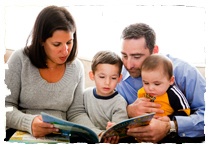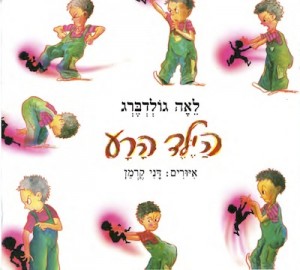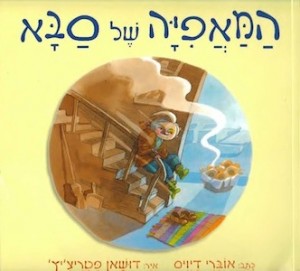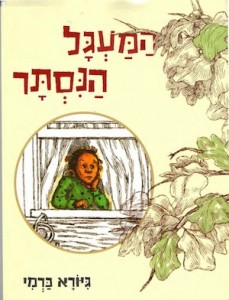by Charlene Klassen Endrizzi, Westminster College, New Wilmington, PA
 “Mothers and fathers have equal duties to read to their children. My daughter-in-law is a lawyer so she comes home from work very tired. My son, who currently stays at home with the children, reads every day at bedtime to his children. He is very close to them through reading.” –Hadass, a trilingual native of Jerusalem, offered these insights into Israeli parent-child reading habits during our bus ride from Tel Aviv to her hometown.
“Mothers and fathers have equal duties to read to their children. My daughter-in-law is a lawyer so she comes home from work very tired. My son, who currently stays at home with the children, reads every day at bedtime to his children. He is very close to them through reading.” –Hadass, a trilingual native of Jerusalem, offered these insights into Israeli parent-child reading habits during our bus ride from Tel Aviv to her hometown.
Across generations and cultures, families create these intimate yet equally intellectual literacy moments with children. The PJ Library, http://www.pjlibrary.org/, is a North American Jewish Family Engagement program designed to perpetuate the parent-child reading tradition. The parallel Israeli version, Sifriyat Pijama, emphasizes the same dual goals of supporting literacy and reaffirming Jewish values. Preschool teachers enrolled in the program receive Jewish literature and music to share with their three to five year old students’ families. One parent must speak Hebrew since all of the books and the Parent Reading Guides at the beginning of each text are written in the official language of Israel.
My research partner Vered’s five year old twins, Rotem and Adi, along with approximately 100,000 other Israeli children, received nine free books, one per month during the past 2011-12 school year. This second blog features three of Vered, Rotem and Adi’s favorite Sifriyat Pijama books. Two of the three books are also available in the U.S. in English since some texts are distributed to families through both organizations, Sifriyat Pijama in Israel and the PJ Library in North America.
Teachers participating in Sifriyat Pijama are expected to explore each book with the whole class before sending it home to parents. Each special edition text includes three pages of parent suggested activities, designed to extend learning opportunities beyond initial book conversations.
The Naughty Boy – The Ups and Downs of Childhood
 The Naughty Boy (Goldberg, 1959) was the first text Vered received from her twins’ Kindergarten teacher. Since Lea Goldberg’s book is a classic familiar to many Israeli parents, Vered explained how she shared this book several years ago with her older son. When Yahel got in trouble, Vered posed the question, “Why did you do that?” to which her son responded, “It’s the bad boy.” This reference demonstrates the power of stories to help children re-examine their lives.
The Naughty Boy (Goldberg, 1959) was the first text Vered received from her twins’ Kindergarten teacher. Since Lea Goldberg’s book is a classic familiar to many Israeli parents, Vered explained how she shared this book several years ago with her older son. When Yahel got in trouble, Vered posed the question, “Why did you do that?” to which her son responded, “It’s the bad boy.” This reference demonstrates the power of stories to help children re-examine their lives.
Goldberg’s story explores the internal struggles of Gad, a normally well-behaved child. “Gad tries so hard to be polite and to satisfy the grown-ups’ wishes, but when least expected, he acts inappropriately, swears, or hits. The adults are angry and disappointed, and Gad wants to explain why he acted the way he did, but feels that nobody understands him. The book depicts aggressive behavior that is experienced at first as uncontrollable. At the end of the story, Gad feels that the naughty boy is part of him. He tries to drive out the naughty boy, and asks him to stop interfering in his life.” www.pjisrael.org
Sifriyat Pajama emphasizes the need for meaningful conversations to occur in conjunction with reading. One of the suggested family activities accompanying this text invites parents to discuss an incident with their child when they struggled to manage their anger. www.sp-ba.org/sites/default/files/activities-suggestions-files/English_activities_the_naughty_boy.pdf Additionally parents are cautioned to avoid such derogatory, outdated labels as the “naughty boy” but instead openly consider inappropriate or hurtful behaviors. In order to consider Gad’s emotional ups and downs along with adult responses, you might enjoy hearing a young Israeli child, Ella Cige, re-enact her version of this story in Hebrew. http://www.youtube.com/watch?v=5Hw-9WqrLjo
Bagels for Benny – Repairing the World (available in English)
 A second book Vered’s twins brought home, Bagels for Benny, was first published in English (Davis, 2003) and later translated into Hebrew (2011). In 2003, Bagels for Benny received the gold medal for the Sydney Taylor Book Award from the Association of Jewish Libraries, a book committee established in North America with a focus on valuing the best Judaic books for young readers.
A second book Vered’s twins brought home, Bagels for Benny, was first published in English (Davis, 2003) and later translated into Hebrew (2011). In 2003, Bagels for Benny received the gold medal for the Sydney Taylor Book Award from the Association of Jewish Libraries, a book committee established in North America with a focus on valuing the best Judaic books for young readers.
Aubrey Davis retells a traditional Jewish tale from Spain, “Challahs in the Ark” (Feinstein, 2008), in a whimsical yet serious manner through the eyes of Benny. Centered around the Jewish values of charity and gratitude, this tale depicts a young child’s efforts to express his thankfulness for his grandfather’s delicious bagels. To summarize,
“Benny says thank you to God, but how does he know that God hears? Why doesn’t God answer? Benny works out a plan: in return for working in his grandpa’s bakery, Benny asks for a bag of bagels every Friday and he leaves them for God in the Holy Ark in the synagogue. Every week the bagels disappear, and Benny is happy that God has taken them. Then Benny and Grandpa see a ragged man take the bagels from the ark and thank God for feeding him; the man says that he has found work at last, and he promises to help others… The story of how a small gesture can make a difference is a moving drama of generosity and faith.” (Rochman, 2004).
While this story contains clear Jewish references such as a holy ark and synagogue, all children need to consider the importance of human kindness, so warmly demonstrated by Benny and his grandpa. It comes as no surprise that Aubrey Davis, a renowned storyteller, retired teacher and former jack-of-all-trades, is the current Director and Corporate Secretary of The Institute for Cross-cultural Exchange (ICE), a charity focused on helping at-risk Canadian, Mexican and Afghan children read and own their own books. http://www.iceeducation.org/
In the Parents’ Reading Guide, the PJ Library emphasizes one key Jewish tenet of repairing the world, “tikkun olam,” by recommending that families help young children consider ways in which they can demonstrate compassion for others, such as donating outgrown toys. http://www.pjlibrary.org/assets/2/books/readingguides/4819bded-1f49-4a2c-86c6-96fd6c48a41c.pdf You can hear Aubrey Davis encourage readers to not look for a single message in his stories but instead use literacy experiences to consider their human potential. http://www.youtube.com/watch?v=Lg7ZjgTgT1k
A Circle of Friends – A Cycle of Goodwill (available in English)
 Rotem and Adi’s third free book, A Circle of Friends (Carmi, 2003), portrays the same theme of charity toward others found in Bagels for Benny. This wordless story depicts a young boy anonymously sharing a snack with a homeless stranger encountered at the park and thereby invoking a cycle of good will. The International Board on Books for Young
Rotem and Adi’s third free book, A Circle of Friends (Carmi, 2003), portrays the same theme of charity toward others found in Bagels for Benny. This wordless story depicts a young boy anonymously sharing a snack with a homeless stranger encountered at the park and thereby invoking a cycle of good will. The International Board on Books for Young
Giora Carmi’s text invites emergent readers to discover the magic of wordless books since anyone can “read” or tell this story, using the pictures. Imaginations are sparked and confidence with books increases as readers tell the story in their own words. I believe A Circle of Friends, like many wordless books, is an ideal literacy experience for ELL students, needing opportunities to build confidence using their second language. Wordless books also encourage creativity in any child by offering an occasion to write her/his own story.
What goes around, comes around seems to be a reoccurring theme in numerous Jewish stories. The popular American movie, Pay It Forward (2000) or even a current Liberty Mutual Insurance television commercial “Acts of Kindness” (2012) emphasize the need to consider how everyone can contribute in small ways to make our world a better place. Psychotherapy with an emphasis on art therapy seems to be a fitting profession for Giora Carmi, the author and illustrator who resides in New York City. Teachers intent on exploring social justice issues could easily use this text as a springboard for a community service project.
The PJ Library website offers various parent-child discussion ideas, some focused on religious texts like the Talmud. Here are two examples:
1. Leaf through the pages with your child and look for instances of giving in the book.
Who gives openly and who gives in secret? The title of the Hebrew version of the
story is “The Hidden Circle”. Why do you think the author chose this title?
2. Look at the illustration of the old man crumbling a bit of his muffin for the birds. In
the Talmud the rabbinical sages say: “Even a poor man who himself survives on
charity should give charity.” What is the logic of this commandment? (www.pjlibrary.org)
These three books, along with the other six books Rotem and Adi brought home, demonstrate Sifriyat Pijama’s and the PJ Library’s commitment to choosing books containing relate-able issues and topics for children. Obviously texts incorporating every day experiences easily evoke a central goal – parent-child conversations.
I recently asked Vered why she read every evening with her children, Yahel, Adi and Rotem. She explained it this way. “I want to interact with my kids, I hope to enrich their vocabulary and develop their imagination, I seek a moment of intimacy with them, and through reading, I can understand better their emotional status.” As a literacy professor in northern Israel, Vered is naturally focused on exploring books with her children. If you want to hear other Israeli mothers’ and fathers’ insights and reactions to Sifriyat Pijama books, just go to their website. http://www.pjisrael.org/page.aspx?id=34
Children’s Books
Carmi, G. (2003). A Circle of Friends. New York, NY: Star Bright Books.
Davis, A. (2003). Bagels for Benny. Toronto, Canada: Kids Can Press.
Feinstein, E. (2008). Capturing the Moon: Classic and Modern Jewish Tales. Springfield, MA: Behrman House.
Goldberg, L. (1959). The Naughty Boy. Tel Aviv, Israel: Sifriat Poalim Publishing Group.
Please visit wowlit.org to browse or search our growing database of books, to read one of our two on-line journals, or to learn more about our mission.
- Themes: Charlene Klassen Endrizzi
- Descriptors: Books & Resources, Debates & Trends, WOW Currents

I am so interested in the concepts behind the PJ Library. I wonder if a similar program would be helpful in promoting the home languages and cultures of other groups! What a powerful tool in connecting a new generation of children to the rich history and culture of their families! Thank you for sharing this resource.
WOW is all I can say after reading these blogs. I chose to comment on this one because I loved the different stories you discussed. “The Naughty Boy” is such an honest, simple tale, yet it communicates a greater message with the children that they will make mistakes (and that’s okay!). Even though they will be naughty sometimes, they have the ability to “drive out” those temptations like the boy does at the end of the story. The second book, “Bagels for Benny” provides a life lesson on the importance of generosity. In a world where people are so concerned about their own needs and wants, it is nice to be reminded to slow down and think about others. The third book, “A Circle of Friends” sounds like a book I really want to purchase! It also has a theme of charity, and the fact that it is wordless makes it all the better! I would love to share a wordless book like this with a group of children, because it would draw on their imagination, creativity, and personal feelings to interpret the story. I think that these interpretations may be more memorable than some of the other children’s books I’ve read. The last thing I will say is that I wish we had a nationwide policy of distributing books throughout the school year, just as the Sifriyat Pijama does. While doing my practicum hours in schools over the last few years, I have had several teachers tell me that so-and-so-student doesn’t have books at home to practice their reading… Could you imagine if every student had nine books by the end of the school year? It would decrease the great gap between socioeconomic classes, and provide students who need it with resources to practice their reading. I think these types of programs should be in place nationwide if our country wants to raise literate and intelligent generations to come.
I agree that students learn so much from reading. This post expresses all the needs that children go through. There will be bullies in their life and hardships they’ll have to face. As a future teacher ill have to find ways to incorporate all of these ideas to them. For example, some students might struggle with anger issues and having a book like “Naughty Boy” will help them to see they can put a stop to their anger. Even “Bagels for Benny” can explain that in life we should always show acts of kindness. My mom always told us, “treat others as we would want to be treated.” This book displays they behavior that if we show kindness to someone then we will receive it back. I feel there is a lot of learning that can come from books. And the more children read them, the more they’ll learn. And this will also foster there love for reading. Use books to teach lessons!
After reading this blog it made me take a step back. I realized that although our countries may be miles apart we are so alike in so many ways. The PJ Library helps promote reading as a family which helps promote reading as a social process. This is so important for the children in the family because it helps them to grow into enthusiastic readers who strive to read more books, longer books and harder books! We are also alike in the themes of books seem across cultures. The book “A Circle of Friends – A Cycle of Goodwill” remind me of the story Pay it Forward which is a motion picture and book. The idea of “what goes around, comes around” as you stated in very popular in a lot of children’s stories like The Boy Who Cried Wolf. I believe that more locations in the United States need to start promoting the idea of a PJ library, because if it’s true what they say, that children are out future then we need them to be literate.
This seems like an amazing program in many different ways. I like how the article started off with once again stating how important it is that mothers and fathers read to their children. I think the concepts of the three books that were summarized are important for all children – behaving, paying it forward, kindness, what goes around comes around, etc. These are real life situations that can spark conversations between parent and child. But most of all it is great to see a program that promotes home languages and cultures. Those children directly affected need to be able to see the value set on their language and culture. It is also important for the other children in a class to see the value placed on other cultures as well.
The PJ Library seems like a wonderful program that all parents could benefit from. I like how it focuses on parent-child communication through literacy. I find it very interesting and unique that the PJ Library is linked with Sifriyat Pijama, and that the books can be found in English or Hebrew. The three books that were mentioned truly relate to a child’s life, and teach wonderful life lessons. One aspect of the PJ Library program that really stood out to me was that it provides activities for the parents to use that go along with the books. This guides parents to really get their children thinking and making connections. This blog also mentioned wordless books which I never considered to be a good choice for school children until now. It is not only useful to ELLs practicing their second language but it is also a great way to get students to be creative, and make up their own story line to go along with the pictures. I really enjoyed reading and learning about the PJ Library program because I think more teachers and parents should consider incorporating programs like this into a child’s daily life. It will not only promote reading, but it will also encourage children to be a good citizens.